Beltane
Beltane or Beltain (/ˈbɛl.teɪn/)[5][6] is the Gaelic May Day festival. Most commonly it is held on 1 May, or about halfway between the spring equinox and the summer solstice. Historically, it was widely observed throughout Ireland, Scotland, Cornwall and the Isle of Man. In Irish the name for the festival day is Lá Bealtaine ([l̪ˠaː ˈbʲal̪ˠt̪ˠənʲə]), in Scottish Gaelic Là Bealltainn ([l̪ˠaː ˈpjaul̪ˠt̪ɪɲ]) and in Manx Gaelic Laa Boaltinn/Boaldyn. It is one of the four Gaelic seasonal festivals—along with Samhain, Imbolc and Lughnasadh—and is similar to the Welsh Calan Mai.
| Beltane | |
|---|---|
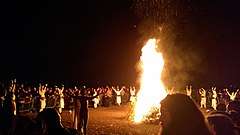 A Beltane bonfire on Calton Hill in Edinburgh | |
| Also called | Lá Bealtaine (Irish) Là Bealltainn (Scottish Gaelic) Laa Boaltinn/Boaldyn (Manx)[1] Beltain; Beltaine; Beltine; Beltany[2][3] |
| Observed by | Gaels (modern Irish people, Scottish people and Manx people), Wiccans, and Celtic neopagans |
| Type | Cultural Pagan (Celtic polytheism, Celtic neopaganism, Wicca) |
| Significance | Beginning of summer |
| Celebrations | lighting bonfires, decorating homes with May flowers, making May bushes, visiting holy wells, feasting |
| Date | 1 May[4] (or 1 November in the S. Hemisphere) |
| Frequency | annual |
| Related to | May Day, Calan Mai, Walpurgis Night |
Beltane is mentioned in some of the earliest Irish literature and is associated with important events in Irish mythology. Also known as Cétshamhain ("first of summer"), it marked the beginning of summer and it was when cattle were driven out to the summer pastures. Rituals were performed to protect the cattle, crops and people, and to encourage growth. Special bonfires were kindled, and their flames, smoke and ashes were deemed to have protective powers. The people and their cattle would walk around or between bonfires, and sometimes leap over the flames or embers. All household fires would be doused and then re-lit from the Beltane bonfire. These gatherings would be accompanied by a feast, and some of the food and drink would be offered to the aos sí. Doors, windows, byres and livestock would be decorated with yellow May flowers, perhaps because they evoked fire. In parts of Ireland, people would make a May Bush: typically a thorn bush or branch decorated with flowers, ribbons, bright shells and rushlights. Holy wells were also visited, while Beltane dew was thought to bring beauty and maintain youthfulness. Many of these customs were part of May Day or Midsummer festivals in other parts of Great Britain and Europe.
Beltane celebrations had largely died out by the mid-20th century, although some of its customs continued and in some places (for example the ’Obby ‘Oss it has been revived as a cultural event. Since the late 20th century, Celtic neopagans and Wiccans have observed Beltane, or something based on it, as a religious holiday. Neopagans in the Southern Hemisphere celebrate Beltane on or around 1 November.
Historic Beltane customs
Beltane was one of four Gaelic seasonal festivals: Samhain (~1 November), Imbolc (~1 February), Beltane (~1 May), and Lughnasadh (~1 August). Beltane marked the beginning of the pastoral summer season, when livestock were driven out to the summer pastures.[7][8] Rituals were held at that time to protect them from harm, both natural and supernatural, and this mainly involved the "symbolic use of fire".[7] There were also rituals to protect crops, dairy products and people, and to encourage growth. The aos sí (often referred to as spirits or fairies) were thought to be especially active at Beltane (as at Samhain)[7] and the goal of many Beltane rituals was to appease them. Most scholars see the aos sí as remnants of the pagan gods and nature spirits.[9] Beltane was a "spring time festival of optimism" during which "fertility ritual again was important, perhaps connecting with the waxing power of the sun".[3]
Before the modern era
Beltane (the beginning of summer) and Samhain (the beginning of winter) are thought to have been the most important of the four Gaelic festivals. Sir James George Frazer wrote in The Golden Bough: A Study in Magic and Religion that the times of Beltane and Samhain are of little importance to European crop-growers, but of great importance to herdsmen. Thus, he suggests that halving the year at 1 May and 1 November dates from a time when the Celts were mainly a pastoral people, dependent on their herds.[10]
The earliest mention of Beltane is in Old Irish literature from Gaelic Ireland. According to the early medieval texts Sanas Cormaic and Tochmarc Emire, Beltane was held on 1 May and marked the beginning of summer. The texts say that, to protect cattle from disease, the druids would make two fires "with great incantations" and drive the cattle between them.[11][12]
According to 17th-century historian Geoffrey Keating, there was a great gathering at the hill of Uisneach each Beltane in medieval Ireland, where a sacrifice was made to a god named Beil. Keating wrote that two bonfires would be lit in every district of Ireland, and cattle would be driven between them to protect them from disease.[13] There is no reference to such a gathering in the annals, but the medieval Dindsenchas includes a tale of a hero lighting a holy fire on Uisneach that blazed for seven years. Ronald Hutton writes that this may "preserve a tradition of Beltane ceremonies there", but adds "Keating or his source may simply have conflated this legend with the information in Sanas Chormaic to produce a piece of pseudo-history."[7] Nevertheless, excavations at Uisneach in the 20th century found evidence of large fires and charred bones, showing it to have been ritually significant.[7][14][15]
Beltane is also mentioned in medieval Scottish literature.[16] An early reference is found in the poem 'Peblis to the Play', contained in the Maitland Manuscripts of 15th- and 16th-century Scots poetry, which describes the celebration in the town of Peebles.[17]
Modern era
From the late 18th century to the mid 20th century, many accounts of Beltane customs were recorded by folklorists and other writers. For example John Jamieson, in his Etymological Dictionary of the Scottish Language (1808) describes some of the Beltane customs which persisted in the 18th and early 19th centuries in parts of Scotland, which he noted were beginning to die out.[18] In the 19th century, folklorist Alexander Carmichael (1832–1912), collected the song Am Beannachadh Bealltain (The Beltane Blessing) in his Carmina Gadelica, which he heard from a crofter in South Uist.[17]
Bonfires
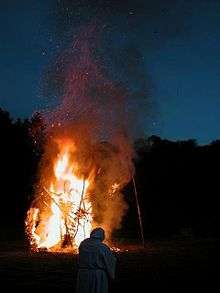
Bonfires continued to be a key part of the festival in the modern era. All hearth fires and candles would be doused before the bonfire was lit, generally on a mountain or hill.[3][19] Ronald Hutton writes that "To increase the potency of the holy flames, in Britain at least they were often kindled by the most primitive of all means, of friction between wood."[7] In the 19th century, for example, John Ramsay described Scottish Highlanders kindling a need-fire or force-fire at Beltane. Such a fire was deemed sacred.[7] In the 19th century, the ritual of driving cattle between two fires—as described in Sanas Cormaic almost 1000 years before—was still practised across most of Ireland and in parts of Scotland.[7] Sometimes the cattle would be driven "around" a bonfire or be made to leap over flames or embers. The people themselves would do likewise.[7] In the Isle of Man, people ensured that the smoke blew over them and their cattle.[8] When the bonfire had died down, people would daub themselves with its ashes and sprinkle it over their crops and livestock.[7] Burning torches from the bonfire would be taken home, where they would be carried around the house or boundary of the farmstead[20] and would be used to re-light the hearth.[7] From these rituals, it is clear that the fire was seen as having protective powers.[7] Similar rituals were part of May Day, Midsummer or Easter customs in other parts of the British Isles and mainland Europe.[21] According to Frazer, the fire rituals are a kind of imitative or sympathetic magic. According to one theory, they were meant to mimic the Sun and to "ensure a needful supply of sunshine for men, animals, and plants". According to another, they were meant to symbolically "burn up and destroy all harmful influences".[22]
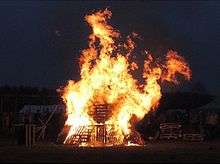
Food was also cooked at the bonfire and there were rituals involving it. Alexander Carmichael wrote that there was a feast featuring lamb, and that formerly this lamb was sacrificed.[23] In 1769, Thomas Pennant wrote that, in Perthshire, a caudle made from eggs, butter, oatmeal and milk was cooked on the bonfire. Some of the mixture was poured on the ground as a libation. Everyone present would then take an oatmeal cake, called the bannoch Bealltainn or "Beltane bannock". A bit of it was offered to the spirits to protect their livestock (one bit to protect the horses, one bit to protect the sheep, and so forth) and a bit was offered to each of the animals that might harm their livestock (one to the fox, one to the eagle, and so forth). Afterwards, they would drink the caudle.[7]
According to 18th century writers, in parts of Scotland there was another ritual involving the oatmeal cake. The cake would be cut and one of the slices marked with charcoal. The slices would then be put in a bonnet and everyone would take one out while blindfolded. According to one writer, whoever got the marked piece would have to leap through the fire three times. According to another, those present would pretend to throw them into the fire and, for some time afterwards, they would speak of them as if they were dead. This "may embody a memory of actual human sacrifice", or it may have always been symbolic.[7] A similar ritual (i.e. of pretending to burn someone in the fire) was practised at spring and summer bonfire festivals in other parts of Europe.[24]
Flowers and May Bushes
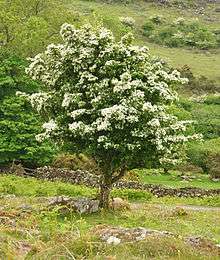
Yellow flowers such as primrose, rowan, hawthorn, gorse, hazel, and marsh marigold were placed at doorways and windows in 19th century Ireland, Scotland and Mann. Sometimes loose flowers were strewn at the doors and windows and sometimes they were made into bouquets, garlands or crosses and fastened to them. They would also be fastened to cows and equipment for milking and butter making. It is likely that such flowers were used because they evoked fire.[7] Similar May Day customs are found across Europe.
The May Bush and May Bough was popular in parts of Ireland until the late 19th century. This was a small tree or branch—typically hawthorn, rowan, holly or sycamore—decorated with bright flowers, ribbons, painted shells, and so forth. The tree would either be decorated where it stood, or branches would be decorated and placed inside or outside the house. It may also be decorated with candles or rushlights.[19] Sometimes a May Bush would be paraded through the town. In parts of southern Ireland, gold and silver hurling balls known as May Balls would be hung on these May Bushes and handed out to children or given to the winners of a hurling match.[19] In Dublin and Belfast, May Bushes were brought into town from the countryside and decorated by the whole neighbourhood.[19] Each neighbourhood vied for the most handsome tree and, sometimes, residents of one would try to steal the May Bush of another. This led to the May Bush being outlawed in Victorian times.[19] In some places, it was customary to dance around the May Bush, and at the end of the festivities it may be burnt in the bonfire.[25]
Thorn trees were seen as special trees and were associated with the aos sí. The custom of decorating a May Bush or May Tree was found in many parts of Europe. Frazer believes that such customs are a relic of tree worship and writes: "The intention of these customs is to bring home to the village, and to each house, the blessings which the tree-spirit has in its power to bestow."[26] Emyr Estyn Evans suggests that the May Bush custom may have come to Ireland from England, because it seemed to be found in areas with strong English influence and because the Irish saw it as unlucky to damage certain thorn trees.[27] However, "lucky" and "unlucky" trees varied by region, and it has been suggested that Beltane was the only time when cutting thorn trees was allowed.[28] The practice of bedecking a May Bush with flowers, ribbons, garlands and bright shells is found among the Gaelic diaspora, most notably in Newfoundland, and in some Easter traditions on the East Coast of the United States.[19]
Other customs
Holy wells were often visited at Beltane, and at the other Gaelic festivals of Imbolc and Lughnasadh. Visitors to holy wells would pray for health while walking sunwise (moving from east to west) around the well. They would then leave offerings; typically coins or clooties (see clootie well).[19] The first water drawn from a well on Beltane was seen as being especially potent, as was Beltane morning dew. At dawn on Beltane, maidens would roll in the dew or wash their faces with it. It would also be collected in a jar, left in the sunlight, and then filtered. The dew was thought to increase sexual attractiveness, maintain youthfulness, and help with skin ailments.[8][19][25]
People also took steps specifically to ward-off or appease the aos sí. Food was left or milk poured at the doorstep or places associated with the aos sí, such as 'fairy trees', as an offering.[29][30] In Ireland, cattle would be brought to 'fairy forts', where a small amount of their blood would be collected. The owners would then pour it into the earth with prayers for the herd's safety. Sometimes the blood would be left to dry and then be burnt.[29] It was thought that dairy products were especially at risk from harmful spirits.[19][31][32] To protect farm produce and encourage fertility, farmers would lead a procession around the boundaries of their farm. They would "carry with them seeds of grain, implements of husbandry, the first well water, and the herb vervain (or rowan as a substitute). The procession generally stopped at the four cardinal points of the compass, beginning in the east, and rituals were performed in each of the four directions".[33]
The festival persisted widely up until the 1950s, and in some places the celebration of Beltane continues today.[15][31][32]
Revival
As a festival, Beltane had largely died out by the mid-20th century, although some of its customs continued and in some places it has been revived as a cultural event. In Ireland, Beltane fires were common until the mid 20th century,[19] but the custom seems to have lasted to the present day only in County Limerick (especially in Limerick itself) and in Arklow, County Wicklow.[34] However, the custom has been revived in some parts of the country. Some cultural groups have sought to revive the custom at Uisneach and perhaps at the Hill of Tara.[35] The lighting of a community Beltane fire from which each hearth fire is then relit is observed today in some parts of the Gaelic diaspora, though in most of these cases it is a cultural revival rather than an unbroken survival of the ancient tradition.[19][36][37] In some areas of Newfoundland, the custom of decorating the May Bush is also still extant.[38] The town of Peebles in the Scottish Borders holds a traditional week-long Beltane Fair every year in June, when a local girl is crowned Beltane Queen on the steps of the parish church. Like other Borders festivals, it incorporates a Common Riding.[39][17]
Since 1988, a Beltane Fire Festival has been held every year during the night of 30 April on Calton Hill in Edinburgh, Scotland. While inspired by traditional Beltane, this festival is a modern arts and cultural event which incorporates myth and drama from a variety of world cultures and diverse literary sources.[40] Two central figures of the Bel Fire procession and performance are the May Queen and the Green Man.[41]
Neo-Paganism
Beltane and Beltane-based festivals are held by some Neopagans. As there are many kinds of Neopaganism, their Beltane celebrations can be very different despite the shared name. Some try to emulate the historic festival as much as possible.[42] Other Neopagans base their celebrations on many sources, the Gaelic festival being only one of them.[43][44]
Neopagans usually celebrate Beltane on 30 April – 1 May in the Northern Hemisphere and 31 October – 1 November in the Southern Hemisphere, beginning and ending at sunset.[45][46][47][48][49] Some Neopagans celebrate it at the astronomical midpoint between the spring equinox and summer solstice (or the full moon nearest this point). In the Northern Hemisphere, this midpoint is when the ecliptic longitude of the Sun reaches 45 degrees.[50] In 2014, this was on 5 May.[51]
Celtic Reconstructionist
Celtic Reconstructionists strive to reconstruct the pre-Christian religions of the Celts. Their religious practices are based on research and historical accounts,[42][52] but may be modified slightly to suit modern life. They avoid modern syncretism and eclecticism (i.e. combining practises from unrelated cultures).[53]
Celtic Reconstructionists usually celebrate Lá Bealtaine when the local hawthorn trees are in bloom. Many observe the traditional bonfire rites, to whatever extent this is feasible where they live. This may involve passing themselves and their pets or livestock between two bonfires, and bringing home a candle lit from the bonfire. If they are unable to make a bonfire or attend a bonfire ceremony, torches or candles may be used instead. They may decorate their homes with a May Bush, branches from blooming thorn trees, or equal-armed rowan crosses. Holy wells may be visited and offerings made to the spirits or deities of the wells. Traditional festival foods may also be prepared.[54][55]
Wicca
Wiccans use the name Beltane or Beltain for their May Day celebrations. It is one of the yearly Sabbats of the Wheel of the Year, following Ostara and preceding Midsummer. Unlike Celtic Reconstructionism, Wicca is syncretic and melds practices from many different cultures. In general, the Wiccan Beltane is more akin to the Germanic/English May Day festival, both in its significance (focusing on fertility) and its rituals (such as maypole dancing). Some Wiccans enact a ritual union of the May Lord and May Lady.[45]
Name
In Irish, the festival is usually called Lá Bealtaine ('day of Beltane') while the month of May is Mí Bhealtaine ("month of Beltane"). In Scottish Gaelic, the festival is Latha Bealltainn and the month is An Cèitean or a' Mhàigh. Sometimes the older Scottish Gaelic spelling Bealltuinn is used. The word Céitean comes from Cétshamain ('first of summer'), an old alternative name for the festival.[56][57] The term Latha Buidhe Bealltainn (Scottish) or Lá Buidhe Bealtaine (Irish), 'the bright or yellow day of Beltane', means the first of May. In Ireland it is referred to in a common folk tale as Luan Lae Bealtaine; the first day of the week (Monday/Luan) is added to emphasise the first day of summer.[58]
The name is anglicized as Beltane, Beltain, Beltaine, Beltine and Beltany.[2]
Etymology
Since the early 20th century it has been commonly accepted that Old Irish Beltaine is derived from a Common Celtic *belo-te(p)niâ, meaning 'bright fire'. The element *belo- might be cognate with the English word bale (as in bale-fire) meaning 'white' or 'shining'; compare Old English bǣl, and Lithuanian/Latvian baltas/balts, found in the name of the Baltic; in Slavic languages byelo or beloye also means 'white', as in Беларусь ('White Rus′' or Belarus) or Бе́лое мо́ре ('White Sea'). A more recent etymology by Xavier Delamarre would derive it from a Common Celtic *Beltinijā, cognate with the name of the Lithuanian goddess of death Giltinė, the root of both being Proto-Indo-European *gʷelH- ("suffering, death").[59]
In Ó Duinnín's Irish dictionary (1904), Beltane is referred to as Céadamh(ain) which it explains is short for Céad-shamh(ain) meaning 'first (of) summer'. The dictionary also states that Dia Céadamhan is May Day and Mí Céadamhan is the month of May.
Toponymy
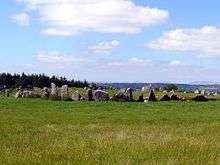
There are a number of place names in Ireland containing the word Bealtaine, indicating places where Bealtaine festivities were once held. It is often anglicised as Beltany. There are three Beltanys in County Donegal, including the Beltany stone circle, and two in County Tyrone. In County Armagh there is a place called Tamnaghvelton/Tamhnach Bhealtaine ('the Beltane field'). Lisbalting/Lios Bealtaine ('the Beltane ringfort') is in County Tipperary, while Glasheennabaultina/Glaisín na Bealtaine ('the Beltane stream') is the name of a stream joining the River Galey in County Limerick.[60]
See also
Calendars
- Celtic calendar
- Coligny calendar
- Irish calendar
Other
- Walpurgis Night
- Welsh Holidays
References
- Celtic myths and legends by Charles Squire ISBN 1-84204-015-4
- "Beltane – The Fire Festival". Newgrange.
- Chadwick, Nora (1970) The Celts London, Penguin. ISBN 0-14-021211-6 p. 181
- "Origins of Bealtaine festival". Irish Independent. 24 April 2013.
- "Beltane". Dictionary.com. Retrieved 1 May 2014.
- "Beltane". Merriam-Webster Dictionary. Retrieved 1 May 2014.
- Hutton, Ronald. The Stations of the Sun: A History of the Ritual Year in Britain. Oxford University Press, 1996. pp. 218–225
- Koch, John T. Celtic Culture: A Historical Encyclopedia. 2006. p. 202
- Santino, Jack. The Hallowed Eve: Dimensions of Culture in a Calendar Festival of Northern Ireland. University Press of Kentucky, 1998. p. 105
- Frazer, Sir James George. The Golden Bough: A Study in Magic and Religion. Forgotten Books, 2008. p. 644
- Stokes, Whitley (ed.) and John O'Donovan (tr.). Sanas Cormaic: Cormac's Glossary. Irish Archaeological and Celtic Society. Calcutta: O.T. Cutter, 1868.
- The Wooing of Emer by Cú Chulainn – Translated by Kuno Meyer. CELT: Corpus of Electronic Texts.
- Keating, Geoffrey. The History of Ireland – Translated by David Comyn and Patrick S. Dinneen. CELT: Corpus of Electronic Texts.
- Patterson, Nerys. Cattle Lords and Clansmen: The Social Structure of Early Ireland. University of Notre Dame Press, 1994. p. 139
- MacKillop, James. A Dictionary of Celtic Mythology. Oxford University Press, 1998. pp. 39, 400–402, 421
- "Dictionary of the Scots Language :: DOST :: Beltane n." www.dsl.ac.uk.
- "The Songs and Rhymes of May" (PDF). Traditional Arts & Culture Scotland. Archived from the original (PDF) on 15 February 2018. Retrieved 15 February 2018.
- "Jamieson's Dictionary Online". www.scotsdictionary.com.
- Danaher, Kevin (1972) The Year in Ireland: Irish Calendar Customs Dublin, Mercier. ISBN 1-85635-093-2 pp. 86–127
- Evans, Irish Folk Ways, pp. 274–275
- Frazer, James George (1922). The Golden Bough: A Study in Magic and Religion. Chapter 62: The Fire-Festivals of Europe.
- Frazer, James George (1922). The Golden Bough: A Study in Magic and Religion. Chapter 63, Part 1: On the Fire-festivals in general.
- Carmichael, Carmina Gadelica Volume 1, p. 191
- Frazer, James George (1922). The Golden Bough: A Study in Magic and Religion. Chapter 64, Part 2: The Burning of Men and Animals in the Fires.
- Clark, Katharine. An Irish Book of Shadows. Galde Press, 2001. p. 172
- Frazer, James George (1922). The Golden Bough: A Study in Magic and Religion. Chapter 10: Relics of Tree Worship in Modern Europe.
- Evans, Emyr Estyn. Irish Folk Ways. Routledge, 1957. pp. 272–274
- Watts, D C. Dictionary of Plant Lore. Academic Press, 2007. p. 246
- Evans, Irish Folk Ways, p. 272
- Danaher, The Year in Ireland, p. 121
- McNeill (1959) Vol. 2. p. 63
- Campbell, John Gregorson (1900, 1902, 2005) The Gaelic Otherworld. Edited by Ronald Black. Edinburgh, Birlinn Ltd. ISBN 1-84158-207-7 pp. 552–554
- Danaher, The Year in Ireland, pp. 116–117
- Council faces clean-up after maybush fires. Wicklow People, 5 May 2005.
- Aideen O'Leary reports ("An Irish Apocryphal Apostle: Muirchú's Portrayal of Saint Patrick" The Harvard Theological Review 89.3 [July 1996:287–301] p. 289) that, for didactic and dramatic purposes, the festival of Beltane, as presided over by Patrick's opponent King Lóegaire mac Néill, was moved to the eve of Easter and from Uisneach to Tara by Muirchú (late 7th century) in his Vita sancti Patricii; he describes the festival as in Temora, istorium Babylone ("at Tara, their Babylon"). There is no authentic connection of Tara with Babylon, nor any known connection of Tara with Beltane.
- Dames, Michael (1992) Mythic Ireland. London, Thames & Hudson ISBN 0-500-27872-5. pp. 206–210
- McNeill, F. Marian (1959) The Silver Bough, Vol. 2. William MacLellan, Glasgow ISBN 0-85335-162-7 p. 56
- "The May Bush in Newfoundland: Newfoundland and Labrador Heritage". Heritage.nf.ca. Retrieved 1 May 2014.
- "Home". Peeblesbeltanefestival.co.uk. Retrieved 1 May 2014.
- Beltane Fire Society – Official event website
- "Beltane Fire Festival". Retrieved 1 March 2019.
- Gallagher, Eugene V.; Ashcraft, W. Michael (2006). Introduction to new and alternative religions in America. Westport, Conn.: Greenwood Press. p. 178. ISBN 0-275-98713-2.
- Adler, Margot (1979) Drawing Down the Moon: Witches, Druids, Goddess-Worshippers, and Other Pagans in America Today. Boston, Beacon Press ISBN 0-8070-3237-9. p. 397 – Excerpts from Manhattan Pagan Way Beltane ritual script, 1978
- McColman, Carl (2003) Complete Idiot's Guide to Celtic Wisdom. Alpha Press ISBN 0-02-864417-4. p. 51
- Starhawk (1979, 1989) The Spiral Dance: A Rebirth of the Ancient Religion of the Great Goddess. New York, Harper and Row ISBN 0-06-250814-8 pp. 181 196 (revised edition)
- Nevill Drury (2009). "The Modern Magical Revival: Esbats and Sabbats". In Pizza, Murphy; Lewis, James R (eds.). Handbook of Contemporary Paganism. Leiden, Netherlands: Brill Publishers. pp. 63–67. ISBN 9789004163737.
- Hume, Lynne (1997). Witchcraft and Paganism in Australia. Melbourne: Melbourne University Press. ISBN 978-0522847826.
- Vos, Donna (2002). Dancing Under an African Moon: Paganism and Wicca in South Africa. Cape Town: Zebra Press. pp. 79–86. ISBN 978-1868726530.
- Bodsworth, Roxanne T (2003). Sunwyse: Celebrating the Sacred Wheel of the Year in Australia. Victoria, Australia: Hihorse Publishing. ISBN 978-0909223038.
- "Equinoxes, Solstice, Cross Quarters shown as seasonal cusps, worshipped by pagans and later religious holidays". Archaeoastronomy.com. Retrieved 5 March 2013.
- "Chart of 2013 equinox, solstice and cross quarter dates and times, worldwide from". archaeoastronomy.com. Retrieved 5 March 2013.
- McColman (2003) pp. 12, 51
- NicDhàna, Kathryn et al. (2007) The CR FAQ: An Introduction to Celtic Reconstructionist Paganism. River House Publishing. ISBN 978-0-615-15800-6 pp. 53–56, 64, 130–131
- NicDhàna (2007) pp. 100–103
- Healy, Elizabeth (2001) In Search of Ireland's Holy Wells. Dublin, Wolfhound Press ISBN 0-86327-865-5 p. 27
- Proceedings of the Harvard Celtic Colloquium, Volume 23. Harvard University Press, 2003. p. 258
- Green, Miranda. The Celtic World. Routledge, 2012. p. 437
- Ó Crualaoich, Gearóid (1 January 1994). "Non-Sovereignty Queen Aspects of the Otherworld Female in Irish Hag Legends: The Case of Cailleach Bhéarra". Béaloideas. 62/63: 147–162. doi:10.2307/20522445. JSTOR 20522445.
- Delamarre, Xavier. Dictionnaire de la langue gauloise, Editions Errance, Paris, 2003, p. 70
- "The Origin And History of Irish Names of Places by Patrick Weston Joyce". 1875. Retrieved 8 October 2017.
Further reading
- Carmichael, Alexander (1992). Carmina Gadelica. Lindisfarne Press. ISBN 0-940262-50-9
- Chadwick, Nora (1970) The Celts. London, Penguin ISBN 0-14-021211-6
- Danaher, Kevin (1972) The Year in Ireland. Dublin, Mercier ISBN 1-85635-093-2
- Evans-Wentz, W. Y. (1966, 1990) The Fairy-Faith in Celtic Countries. New York, Citadel ISBN 0-8065-1160-5
- MacKillop, James (1998). Dictionary of Celtic Mythology. Oxford University Press ISBN 0-19-280120-1
- McNeill, F. Marian (1959) The Silver Bough, Vol. 1–4. William MacLellan, Glasgow
- Simpson, Eve Blantyre (1908), Folk Lore in Lowland Scotland, London: J.M. Dent.
